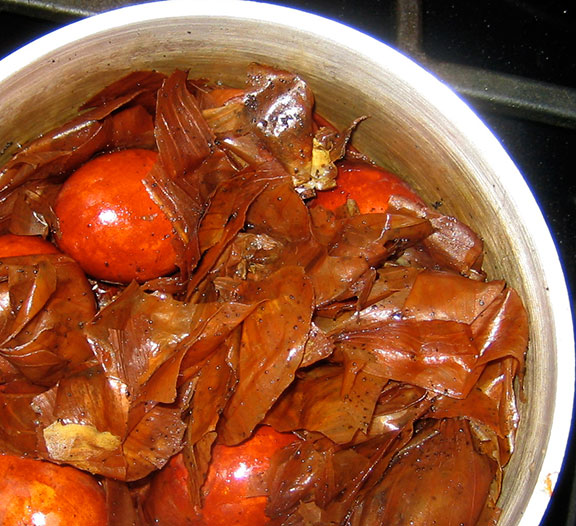©Jennifer Felicia Abadi: www.JenniferAbadi.com
Two months before Passover, Deanna Marcus starts saving her onion skins (yellow, white, and red), while June Hersh remembers her mother telling the produce man to save them for her in anticipation of the holiday. Huevos means “eggs” in Spanish, and the word Haminados comes from the Hebrew word Cham meaning, “hot.” In the Sephardic world Huevos Haminados (browned whole eggs in the shell) are baked all year round, served alongside such pastries as cheese or potato borekas, or baked in the Shabbat stew known as Chamin/Hamin. When slow-cooked, the onion skins turn the whites of the eggs inside into a beautiful beige color, imparting a delicate caramel flavor. Shade and intensity of the egg’s color inside and out will depend on the quantity of the onion skins and coffee used, the variety of onions, and the length of time they cook (in the Yemenite tradition some add red wine vinegar as well). For Passover, one of the browned eggs is used for the Seder plate, while the rest are served as the first course to the dinner. The bottom line is, if you plan to prepare these delectable treats, you need a ton of onion skins. So start collecting now!
Yield: Serves 6 / Makes 6 Brown Eggs
INGREDIENTS:
1 tablespoon coffee grinds
8 to 10 loosely packed cups onion skins (just the outermost thin brown layers)
½ teaspoon salt
2 tablespoons olive oil
4 cups cold water
6 large white eggs
EQUIPMENT:
Measuring cups and spoons
Medium mixing bowl
Large, heavy-bottomed pot with lid
PROCEDURE:
1. Combine all of the ingredients except the eggs in a medium sized mixing bowl.
2. Create a nest at the bottom of a medium sized, heavy-bottomed pot with half of the onion skin mixture.
3. Gently place the eggs on top of the onion skins, then cover them with the remaining half of the onion skins.
4. Bring water to a boil over high heat and boil the eggs for 5 minutes.
5. Lower heat to the lowest setting on your stove, cover with a tight-fitting lid, and steam the eggs until the shells obtain a caramel-brown color on the outside, about 4 to 5 hours minimum. (Note: These eggs traditionally were slow-baked in the oven overnight, so if you have the time you can do it that way or keep cooking the eggs on the stovetop for about
10 hours total.)
6. Rinse off the eggs and cool to room temperature before serving at the seder meal. Leftover eggs may also be refrigerated to be eaten the next day as a delicious snack or as part of a lunch.


I came across your article while trying to find out if the eggs I had just boiled (for way longer than necessary I got distracted) were brown because I had boiled them too long or if they were bad. I ate one and it was a little different, but definitely not bad, but I still wanted to check so I could explain to my 90-year-old mother that they were OK. All the better that these are Jewish eggs, because we are about to make salt water, a family recipe from my mother s Polish-born mother, for Passover. That involves about 10 chopped hard boiled eggs, one large chopped onion, salt and pepper, and water. (We always use the same blue ceramic pot, so I have no idea how much water, just enough to fill the pot.) Refrigerate and serve cold. It is better the second day. So this year we will use Sephardic eggs for an Ashkenazi recipe.
Glad you found me and my blog when looking for information about eggs! Yes it sounds like you would be a good candidate for the Sephardic brown eggs that are prepared for Passover. They look nice too!